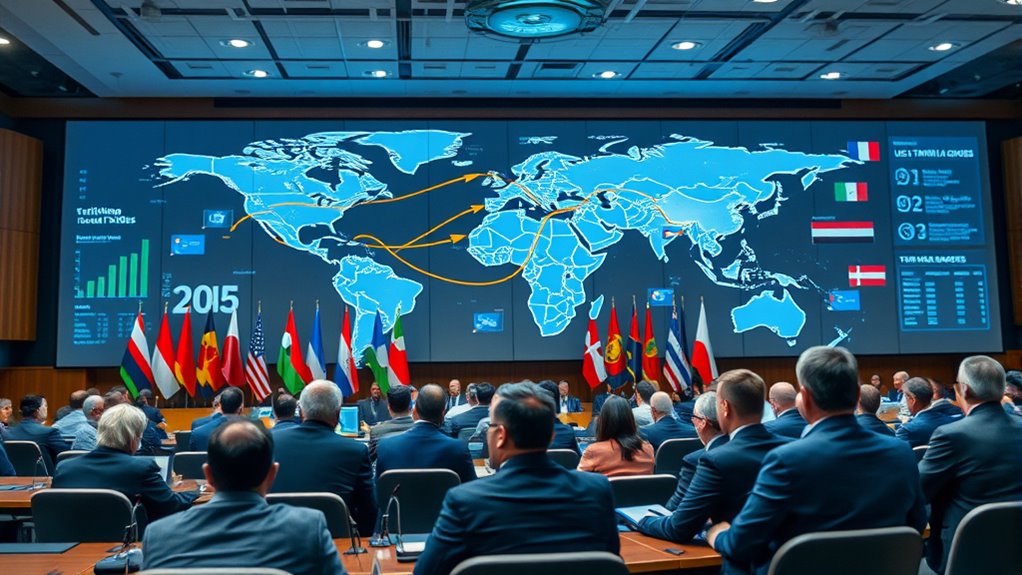In 2025, US tariff policies aim to balance protecting domestic industries with fostering international relations. You’ll see tariffs lowered on essential goods to ease inflation but maintained or increased on strategic imports for national security. These policies are shaped by geopolitical goals, prompting other countries to adjust their trade strategies, sometimes retaliating or shifting supply chains. As the US works with global organizations, the evolving trade landscape impacts markets worldwide. Continue exploring to see how these shifts influence the global economy.
Key Takeaways
- US tariffs in 2025 aim to balance protecting domestic industries with fostering international cooperation.
- Trade policies are influenced by geopolitical strategies, especially in Asia and Europe, affecting tariff levels and negotiations.
- Countries adapt through retaliatory tariffs, shifting supply chains, and seeking alternative markets to mitigate US trade impacts.
- Multilateral organizations promote negotiations to prevent escalation of trade tensions and support fair dispute resolution.
- Overall, US tariff strategies in 2025 will shape global trade flows, supply chains, and diplomatic relationships.

How will US tariff policies evolve in 2025? This question sits at the forefront of global economic conversations, and as you look ahead, you’ll find that the trajectory of US tariffs will substantially influence trade dynamics and international relations. While it’s impossible to predict every move with certainty, emerging trends suggest a cautious yet strategic approach by policymakers. The Biden administration, for instance, may continue to balance protecting domestic industries with fostering international cooperation. You might see efforts to reduce tariffs on essential goods to ease inflation pressures, while maintaining or even increasing tariffs on certain imports to bolster national security or protect key industries. This nuanced stance reflects an understanding that tariffs are powerful tools, but they come with risks of retaliation and economic disruptions.
US tariff policies in 2025 will balance protecting domestic industries with strategic international cooperation.
In 2025, US tariff policies are likely to be shaped by broader geopolitical considerations. You’ll notice an increasing emphasis on aligning trade policies with strategic alliances, especially with allies in Asia and Europe. This could involve negotiating trade agreements that minimize tariffs or establishing new frameworks that promote fair competition. Conversely, you might also see the US adopting a more assertive stance toward countries it perceives as economic threats, like China, by implementing targeted tariffs aimed at addressing intellectual property theft or unfair trade practices. These moves could escalate trade tensions, prompting responses that ripple through global markets.
Trade reactions from other nations will also play a vital role. Countries will adapt their strategies based on US policies, either by seeking alternative markets or by retaliating through their own tariffs. You may observe shifts in supply chains, with companies relocating manufacturing or sourcing from different regions to avoid tariffs and maintain profitability. Such adjustments could reshape global trade flows, making some markets more attractive while rendering others less viable. As global economic leaders continue to navigate these changes, the potential for trade disruptions to impact economic stability remains significant.
Furthermore, the international community’s response will influence the effectiveness of US tariffs. Multilateral institutions might push for negotiations or dispute resolutions to prevent trade wars from spiraling out of control. As a result, you could see a mix of cooperation and confrontation shaping the landscape. Overall, US tariffs in 2025 are poised to be a balancing act—aimed at safeguarding domestic interests while navigating complex international relationships. Your understanding of these evolving policies will help you anticipate shifts in global markets, supply chains, and diplomatic ties, making it clearer how the US’s approach to tariffs will impact the world stage in the years ahead.
Frequently Asked Questions
How Will US Tariffs Impact Emerging Economies?
Your emerging economy could face higher costs and reduced export opportunities due to US tariffs. These measures may lead to decreased demand for your goods, disrupt supply chains, and trigger retaliatory actions from other countries. You might also see inflationary pressures and slowed economic growth. To navigate this, stay adaptable by diversifying markets, improving competitiveness, and strengthening regional trade partnerships to mitigate the adverse effects of US tariff policies.
What Are the Long-Term Effects on Global Supply Chains?
The long-term effects on global supply chains could be monumental, reshaping international trade as you know it. Tariffs might force you to diversify suppliers, increase costs, and create unpredictable delays, effectively turning supply chains into a complex web of shifting alliances. You may see more regional production, which could either strengthen local economies or fragment global markets. Ultimately, these changes will demand agility and strategic planning to stay competitive in an evolving landscape.
How Will Neighboring Countries Adapt to New Tariffs?
You’ll need to diversify your supply sources and seek alternative markets to mitigate tariff impacts. Investing in local production can reduce dependency on US imports, while negotiating trade agreements might offer some relief. Keep a close eye on policy changes and adapt quickly to shifts in tariffs. Collaborate with regional partners to create resilient supply chains, ensuring your business remains competitive despite the evolving trade landscape.
What Specific Industries Are Most Affected by These Tariffs?
You’ll notice the manufacturing, agriculture, and technology sectors bear the brunt of these tariffs. Manufacturing faces higher costs and supply chain disruptions, agriculture struggles with export declines, and technology confronts increased import prices. These industries, essential to your economy, experience reduced competitiveness, job uncertainties, and market shifts. The ripple effects influence your daily life, from the products you buy to the jobs you hold, highlighting the tangible impacts of tariff policies.
Will US Tariffs Influence Global Trade Agreements?
Yes, US tariffs will influence global trade agreements. You’ll find other countries may retaliate or renegotiate deals to protect their own industries. This can lead to shifts in alliances, new trade barriers, or revised agreements that better suit each nation’s interests. As a result, global trade dynamics become more complex, and you might see increased uncertainty and disruptions in supply chains, impacting international commerce and economic stability worldwide.
Conclusion
As you watch the evolving US tariff policies in 2025, remember that “a rising tide lifts all boats.” These changes will reshape global trade dynamics, impacting economies worldwide. Staying informed helps you navigate these shifts and seize new opportunities. While uncertainty remains, adaptability is your best tool. Keep an eye on how nations respond, because, in the end, understanding the bigger picture empowers you to make smarter decisions in this ever-changing landscape.









